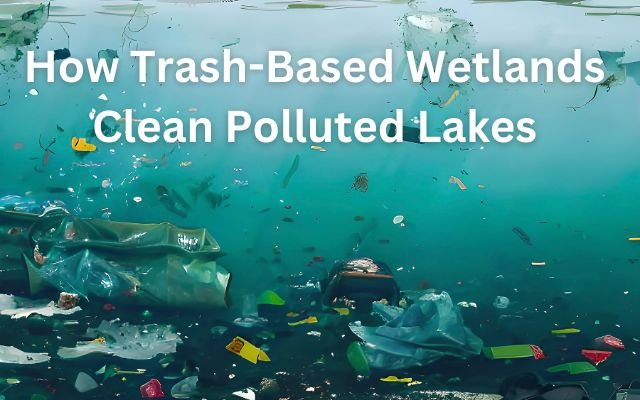Transforming Trash into Clean Water: How Floating Wetlands Are Purifying Polluted Lakes
How Floating Wetlands Filter Pollutants from Water

Discover how floating wetlands made from trash are transforming polluted lakes into cleaner, healthier ecosystems.
On the banks of Nagdaha, a polluted lake in Nepal, Soni Pradhanang is intentionally placing trash into the water. She assembles a platform using styrofoam, bamboo mats and other waste materials, then plants 55 flowers on it. This simple setup is actually a low-cost water-filtration system.
Pradhanang, a hydrologist at the University of Rhode Island, has been developing these trash-based systems, known as floating treatment wetland systems (FTWS), for the past seven years. These platforms float on water, and the plants on them absorb pollutants, releasing oxygen that benefits aquatic life.
The goal is to clean polluted waters while recycling waste in areas with limited resources. Pradhanang also advises The Small Earth Nepal, a group that has been working for five years to implement these systems in Nagdaha and in other polluted waters in India and Bangladesh.
These floating treatment systems are not very large—each mat is about the size of a full-size mattress. However, they can be connected to form clusters that treat bigger areas of water. In Nagdaha, where these systems have been floating for nearly two years, there are five clusters, each made up of eight platforms. According to The Small Earth Nepal, these systems have significantly reduced levels of nitrates, heavy metals and phosphorus in the lake.
Pradhanang, who was born and raised in Kathmandu, Nepal, has always focused her water-quality projects in South Asia. She deeply understands the water challenges faced by Nepalese citizens, such as pollution from sewage, industry, and agriculture, limited water treatment facilities, and the need to use the same water bodies for multiple purposes, like washing clothes and bathing. Pradhanang worked with local farmers & foresters in Nepal to address their water needs in the context of climate change prior to beginning work on the floating wetland project.
“My roots are back there,” says Pradhanang. “I am naturally drawn to the community that I have been a part of.”
In the US, floating treatment wetland systems have been gaining popularity over the past few years. This growth is driven by companies scaling up the production of proprietary, non-trash-based platforms, and cities noticing the success of others. Urban waterways like Baltimore’s Inner Harbor, Boston’s Charles River, and the Chicago River have all successfully used FTWS to clean their waters.
When Pradhanang wanted to bring these systems to polluted water bodies in Nepal, she encountered a significant challenge: the cost. The proprietary bases, typically made from recycled and water-resistant materials, cost over $600 each in 2018. “That’s around 70,000 Nepalese rupees per unit—equivalent to someone’s one-year salary,” she says.
To overcome this, Pradhanang developed a method she calls “trash for cash,” where the “cash” is improved water quality. She reasoned that if the mats were built using local waste, they would be nearly free. In 2017, she tested this idea in her Rhode Island lab, using materials like oyster traps, bubble wrap, and BPA-free plastic water bottles to see if trash-based mats loaded with plants could effectively improve water quality.
Building your own Floating Treatment Wetland System (FTWS) is more challenging than it seems. Sarah White, a water quality scientist at Clemson University in South Carolina, explains that finding materials that stay buoyant and watertight over time is tough.
When Pradhanang finally found a mix of trash that could be turned into a sturdy, long-lasting platform, she began discussing her findings with her colleagues in Nepal. By 2021, they had secured $78,000 in funding from the Asia-Pacific Network for Global Change Research to conduct a study across Nepal, India, and Bangladesh.
The sites in Nagdaha, India, and Bangladesh don’t provide drinking water, but they hold cultural and religious importance. During her visits to Nepal, Pradhanang has observed children swimming in Nagdaha’s murky waters, dogs drinking at the shore, and women washing dishes and clothes by the lake. Pradhanang and The Small Earth Nepal aimed to beautify the lake while also cleaning it. They chose flowering plants like Indian shot (Canna indica) and scarlet sage (Salvia splendens), which have bright red flowers that contrast with the gray water, serving both aesthetic and practical purposes.
After installing the floating platforms in the fall of 2022, the team tested the water monthly. The results matched their lab trials: nitrate levels dropped by 99%, phosphates by 80%, iron by 56%, and ammonia by 55%. Dissolved oxygen levels increased by 50%. These findings have been submitted to the Journal of Civil Engineering for review.
While growing flowering plants on the platforms enhances the lake’s appearance, the team avoids growing food plants because of the high levels of pollutants the plants absorb. Interestingly, the floating wetlands have also attracted geese and ducks, who sit on the platforms and add phosphorus-rich waste to the water.
Pradhanang found a clever way to deal with the mallards that were causing trouble on the floating treatment wetland systems (FTWS). She tied silver ribbons around the stems of the plants, creating a sharp glare that scared the birds away. While the team doesn’t want geese on the platforms, they welcome pollinators like bees and small birds. These creatures, along with the diverse microbial life that thrives on the plant roots, play a crucial role in digesting pollutants in the water for energy.
Max Rome, who completed his PhD studying FTWS in Boston’s Charles River, noted that these systems are highly effective in creating wetland biodiversity in areas where there isn’t enough space for traditional wetlands. “There’s a real kind of, ‘If you build it, they will come’ phenomenon associated with the floating wetlands,” he said.
Although the trash-based FTWS help solve some water pollution problems, they also raise concerns, particularly regarding microplastics. The mats are often made from local waste, including materials that might have been gathered from the water itself. However, the high plastic content in the water can still pose health risks to the local population, even after the water has been cleansed.
Despite these reservations, Pradhanang and other researchers think that the trash-based FTWS generally has more advantages than disadvantages. Although it may be problematic to use materials like Styrofoam & other plastics in the mats, these systems have a major positive impact on the quality of the water. Sarah White, a water quality and treatment scientist, summed it up by saying, “If you can use a waste product that would normally just be in the water, and you can use it to make something that actually helps clean the water, it’s amazing.”
Pradhanang stresses that floating treatment systems (FTWS) only do good if they are well-maintained. If people neglect them, parts can come loose and turn back into trash, which would defeat the purpose. While the community has mostly responded positively to these systems, there’s a need to show their effectiveness to ensure they last after the researchers leave.
Dr. Ritu Singh, an assistant professor at the Central University of Rajasthan and the lead for India in this collaboration, highlights the importance of demonstrating how these systems clean water. If locals don’t understand this, the mats could become just another burden for them to manage. This isn’t just a challenge in South Asia; similar issues have been observed in the U.S. South, where some homeowners didn’t know the floating mats near their homes helped treat water. A study in Sri Lanka also found that locals often saw floating wetlands as purely decorative.
Once people know the benefits of FTWS, maintaining them is relatively simple—usually just biannual pruning and root trimming. However, with the initial grant from the Asia-Pacific Network for Global Change Research now spent, Pradhanang and The Small Earth Nepal are working to hand over maintenance duties to local groups. They’ve held workshops on how to care for the systems and their benefits, and they’ve even briefed mayors, water officials and community leaders at all three project sites. To encourage community ownership, they’re offering advertising space on the platforms, allowing locals to use the revenue for maintenance.
Expanding beyond the three current sites or even maintaining them requires local policy support and funding. While the FTWS are low-cost, there are still expenses like paying for labor and materials such as bamboo mats and plants. Kathmandu Valley Water Supply Board has shown interest in using FTWS at other locations and Pradhanang plans to visit Nepal to discuss future steps. She’s also shared her methods with a university in Banjarmasin, Indonesia which hopes to use these systems in its own polluted waters.
- Inside the Airbus Factory: A Rare Glimpse at How Planes Are Made
- Chandrayaan-3’s Shocking Moon Discovery: Did a Magma Ocean Once Flow?
- The Wow! Signal: A New Theory That’s Out of This World (But Not Aliens)
Although securing funding and scaling up are ongoing concerns, Pradhanang has found that engaging with local residents and understanding their needs is key to success. She emphasizes that while researchers talk about removing chemicals like phosphorus, ammonia and nitrate, what really matters to communities is simply having clean water.



